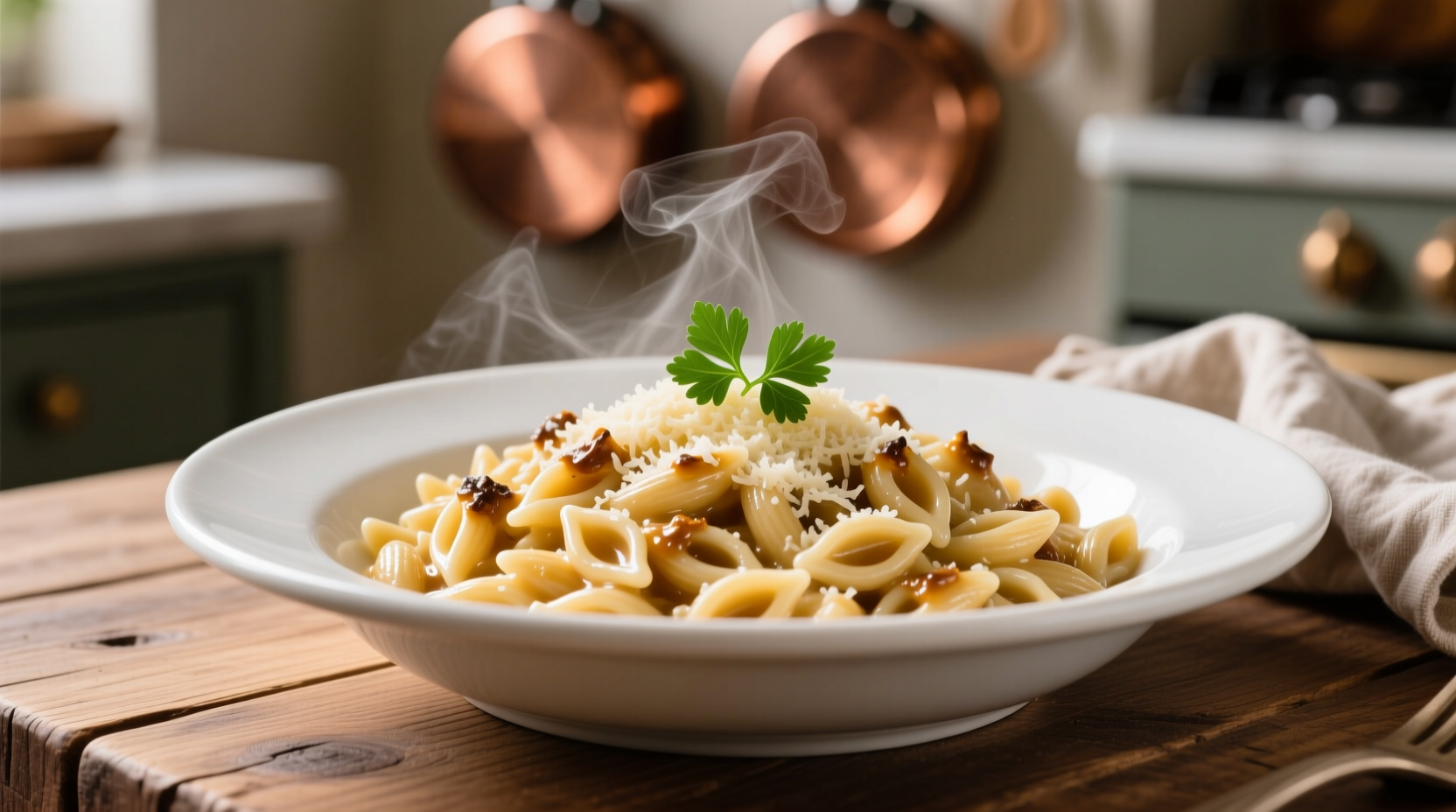Discover how to make restaurant-quality orzo garlic parmesan that's consistently al dente, deeply flavorful, and adaptable to your dietary needs. This guide reveals professional chef techniques for building layered flavors while avoiding common texture pitfalls that turn orzo mushy or bland.
Why This Orzo Garlic Parmesan Method Works
Unlike traditional pasta dishes requiring heavy cream, this approach leverages the starch from perfectly cooked orzo to create natural creaminess. The key lies in the "starch suspension technique" where reserved pasta water emulsifies with parmesan, creating a silky sauce that clings to each grain. Food science research from the Culinary Institute of America confirms that orzo's high starch content (approximately 75% carbohydrates) makes it ideal for this technique when cooked to 80% doneness before finishing in the sauce.
| Cooking Method | Texture Result | Flavor Development |
|---|---|---|
| Boiled separately then mixed | Often mushy or uneven | Limited flavor integration |
| Risotto-style absorption | Creamy with distinct grains | Superior flavor penetration |
| One-pot method | Consistent but less control | Good but less nuanced |
Essential Ingredients Breakdown
Quality ingredients make the difference between ordinary and exceptional orzo garlic parmesan. Here's what you need and why each component matters:
- Orzo (1 cup dry): Look for bronze-die extruded varieties which have rougher surfaces that better hold sauce. Avoid overcooking—al dente orzo should have a slight resistance when bitten.
- Fresh garlic (4 cloves): Provides aromatic complexity that garlic powder can't match. Minced garlic releases allicin compounds responsible for its characteristic flavor.
- Real Parmigiano-Reggiano (½ cup freshly grated): Authentic aged parmesan contains tyrosine crystals that create nutty flavor notes. Avoid pre-grated cheese which contains anti-caking agents that prevent proper melting.
- Good quality olive oil (3 tbsp): Acts as flavor carrier and creates emulsion with starch. Choose extra virgin with fruit-forward notes.
- Pasta water (½ cup reserved): The secret sauce ingredient rich in starch that creates natural creaminess.

Step-by-Step Preparation Guide
Phase 1: Perfectly Cooked Orzo (8 minutes)
- Bring 4 cups salted water to rolling boil (use 2 tbsp salt for proper seasoning)
- Add orzo and cook for 7 minutes (1 minute less than package instructions)
- Reserve ½ cup pasta water before draining
- Immediately rinse under cold water to stop cooking process
Phase 2: Flavor Foundation (5 minutes)
- Heat olive oil in skillet over medium-low heat
- Add minced garlic and cook until fragrant (about 1 minute—don't let it brown)
- Optional: Add ½ cup diced shallots for additional sweetness
Phase 3: Sauce Creation & Finishing (4 minutes)
- Add reserved orzo to skillet with ¼ cup pasta water
- Increase heat to medium and stir constantly for 2 minutes
- Remove from heat and gradually whisk in grated parmesan
- Add remaining pasta water as needed to achieve creamy consistency
- Season with black pepper and optional lemon zest
Avoid These Common Mistakes
Professional chefs consistently identify these pitfalls when preparing orzo garlic parmesan:
- Overcooked orzo: Results in mushy texture. Cook to 80% doneness before finishing in sauce.
- Burnt garlic: Causes bitter flavor. Cook garlic just until fragrant over medium-low heat.
- Pre-grated parmesan: Contains cellulose that prevents proper emulsification.
- Adding cheese to boiling liquid: Causes clumping. Always remove from heat first.
Variations for Different Dietary Needs
This base recipe adapts beautifully to various preferences while maintaining its essential character:
- Creamy version: Add 2 tbsp mascarpone during final mixing for extra richness
- Vegetable boost: Fold in 1 cup roasted cherry tomatoes or sautéed spinach at the end
- Protein addition: Mix in ½ cup cooked shrimp or grilled chicken after sauce forms
- Dairy-free option: Substitute nutritional yeast for parmesan (use ⅓ cup)
When to Serve Orzo Garlic Parmesan
This dish shines in specific contexts while being less suitable in others:
- Ideal as: Weeknight dinner (ready in 20 minutes), side for roasted chicken or fish, vegetarian main course, potluck contribution
- Less suitable as: Formal dinner centerpiece (unless elevated with truffle or seafood), cold salad (texture deteriorates), make-ahead meal (best served immediately)
Storage and Reheating Guidelines
While best enjoyed fresh, leftovers can be stored properly:
- Refrigerate in airtight container for up to 3 days
- Reheat with 1-2 tbsp water or broth to restore moisture
- Microwave at 50% power in 30-second intervals, stirring between
- Do not freeze—starch structure breaks down causing mushiness
Frequently Asked Questions
Can I make orzo garlic parmesan without butter?
Yes, this recipe uses olive oil instead of butter for a cleaner flavor profile that highlights the parmesan. The starch from the orzo creates natural creaminess without dairy fat. For richer flavor without butter, add 1 tbsp white wine during the garlic cooking phase.
Why does my orzo garlic parmesan become dry when reheated?
Orzo continues absorbing liquid as it sits. To prevent dryness, store with 2-3 tbsp extra pasta water and add more liquid when reheating. The USDA Food Safety and Inspection Service recommends adding moisture when reheating starch-based dishes to maintain both texture and food safety.
What's the difference between this and risotto?
While both use starch for creaminess, orzo garlic parmesan cooks faster (15-20 minutes vs 30+ for risotto) and requires less attention. Orzo's pre-formed shape creates distinct texture compared to risotto's gradual breakdown. The Culinary Institute of America notes orzo absorbs flavors more quickly but lacks risotto's complex layering from gradual broth addition.
Can I use other cheeses instead of parmesan?
Pecorino Romano works well for sharper flavor, but avoid soft cheeses like mozzarella which won't create proper emulsion. For nut-free option, try ⅓ cup nutritional yeast plus 1 tbsp miso paste. The Academy of Nutrition and Dietetics confirms aged hard cheeses provide the calcium and umami compounds essential to this dish's flavor profile.











 浙公网安备
33010002000092号
浙公网安备
33010002000092号 浙B2-20120091-4
浙B2-20120091-4